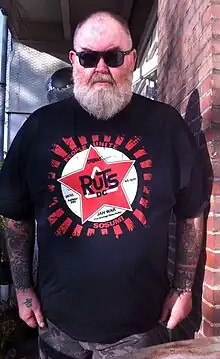Big John Duncan | |
|---|---|
 Duncan in 2016 | |
| Background information | |
| Birth name | John Duncan |
| Born | August 14, 1958 Glasgow, Scotland |
| Genres | Street punk, indie rock |
| Instrument(s) | Guitar |
| Labels | Secret, Captain Oi! Records, Exploited, Capitol, Radioactive, Blokshok, Parlophone |
John Duncan (born August 14, 1958), better known as Big John Duncan, is a musician and guitarist. He is best known as the guitarist for The Exploited[1] during their classic lineup of 1979 – 1984.[2] He played and wrote the music for their albums Punks Not Dead, Troops Of Tomorrow and Let's Start a War. He also played and wrote many of their single releases, the most famous being "Dead Cities" which they performed on Top of the Pops in 1981.
After their American tour in 1983, Duncan quit The Exploited. He then went on to play in several bands including Human Zoo, Crazy Maybe, and Blood Uncles, and then in 1988 joined Goodbye Mr Mackenzie[3] (with future Garbage singer Shirley Manson). In 1992 and 1993 he worked as a backline and guitar technician for the band Nirvana[4] and played guitar with them during their concert in Roseland Ballroom, New York City on 23 July 1993.[2][5] In the early and mid '90s he played with The Kamikaze Freak Show and the Gin Goblins.
In 2019, he joined with remaining bandmates for a Goodbye Mr Mackenzie 30th anniversary reunion tour.[3]
Duncan worked with many other bands during his career including Twisted Sister, the Foo Fighters and Ministry.
References
- ↑ "Big John Duncan est le héros oublié du punk rock". www.vice.com (in French). Retrieved 15 May 2023.
- 1 2 Strong, Martin C. (2001) The Great Metal Discography, MOJO Books, ISBN 1-84195-185-4, p. 189
- 1 2 "Exploited guitar legend to rejoin Goodbye Mr Mackenzie for anniversary gigs". Edinburgh News. 13 May 2019. Retrieved 15 May 2023.
- ↑ "BIG JOHN DUNCAN - interview by Peek-A-Boo magazine". www.peek-a-boo-magazine.be. Retrieved 15 May 2023.
- ↑ "Nirvana Live Guide - 1993". Archived from the original on 23 April 2013. Retrieved 26 May 2016.